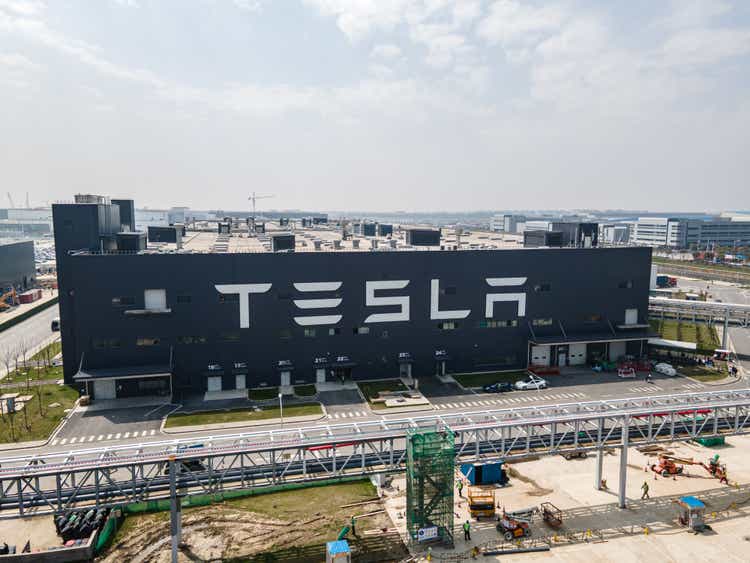Summary:
- Tesla showing 40% topline growth under recession fears, rising interest rates, and lockdown risks is impressive.
- The long-term outlook for Tesla remains positive.
- Tesla achieved operational excellence, despite the supply chain problems.
- Elon Musk already has announced he will leave Twitter.
Xiaolu Chu
Tesla, Inc. (NASDAQ:TSLA) growth prospects have recently been called into question after the company announced that it delivered 405,278 vehicles in Q4 2022, missing analysts’ estimates of 400,000 to 430,000 vehicles. While this news has led some to believe that it is the end of the world for Tesla, a closer examination of the company’s performance reveals a more nuanced picture.
First and foremost, it is important to consider the challenges that Tesla faced in 2022, including rising interest rates, a global economic slowdown, and economic uncertainty. These factors likely contributed to the slowdown in demand and the increase in inventories in December 2022, as well as the decision to offer discounts in an effort to boost sales.
Despite these challenges, however, Tesla still managed to achieve impressive year-over-year, YoY, growth in both deliveries (40.34%) and production (47%) in 2022, totaling 1.314 million and 1.37 million, respectively. This is especially impressive considering the difficulties faced by the company in the year, as well as the fact that it fell short of its long-term delivery target of 50%.
It is important to keep in mind that the long-term topline growth rate of any company will not be a constant number, and it is structurally impossible for it to be so. The topline growth rate in any industry fluctuates based on systemic and un-systemic risks, as well as the cyclical nature of the industry.
In the case of Tesla, the company has set a long-term growth target of 50%, which it will likely achieve on average over time. Investors should not become overly focused on this number and assume that any deviation from it signals the end of the world for the company. In fact, Tesla achieved 40% topline growth and 47% production growth in 2022, a year marked by numerous challenges such as supply chain issues, recession fears, rising interest rates, and Covid-19-related restrictions in China. This strong performance in the face of these difficulties demonstrates the resilience and potential for growth of the company, even with Elon Musk being active on Twitter.
Another factor to consider is Tesla’s performance in the Chinese market, which is the largest market for electric vehicles (“EVs”). Leading Chinese EV makers also reported their quarterly numbers recently as well, and Tesla is currently outperforming its competition in the country. This bodes well for the company’s future growth, as China is expected to fully ease Covid-19 restrictions in the first quarter of 2023 – already easing the covid restriction – potentially offsetting weakness in Europe and North America.
Additionally, while price cuts may hurt margins in the short term, they could also help to increase Tesla’s market share, which would ultimately protect its topline growth. Once a customer buys a Tesla, they are likely to remain loyal to the brand, and the rate of decline in topline and margins will likely be slower as a result.
The decision by Tesla CEO Elon Musk to leave Twitter may also be a positive for the company, as it allows him to focus more on Tesla’s operations.
Furthermore, the overall trend of increasing adoption of EVs, with total EV units expected to reach 46.8 million by 2030 according to one estimate, bodes well for Tesla’s future growth. Governments around the world are increasingly targeting the phase-out of combustion engines, and the adoption of EVs as a means of promoting sustainable development.
There are certainly risks to consider when investing in Tesla. One macro risk is the potential pushback against the elimination of combustion engines and the impact this could have on the company’s growth. Additionally, the Chinese government’s policy towards Tesla is a potential risk, as the government has a history of taking direct or indirect control of companies and could potentially do so with Tesla.
Another risk is the possibility of Elon Musk leaving Tesla. While it is difficult to predict when this might happen, his departure could potentially have a significant impact on the company’s operations and future growth. These risks should be carefully considered by investors before making any investment decisions.
While there may be short-term challenges and fluctuations in Tesla’s growth, the long-term outlook for the company remains positive. Its strong brand loyalty and expanding market for EVs give it a solid foundation for continued growth in the future.
Disclosure: I/we have a beneficial long position in the shares of TSLA either through stock ownership, options, or other derivatives. I wrote this article myself, and it expresses my own opinions. I am not receiving compensation for it (other than from Seeking Alpha). I have no business relationship with any company whose stock is mentioned in this article.
Additional disclosure: Client accounts own TSLA and options traded actively.
